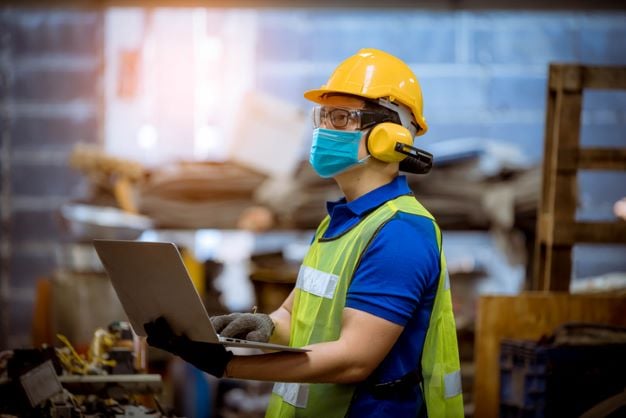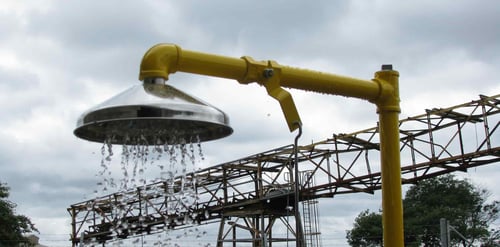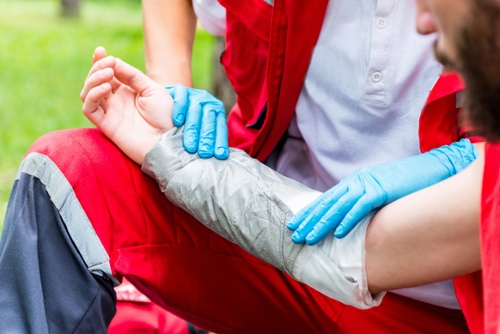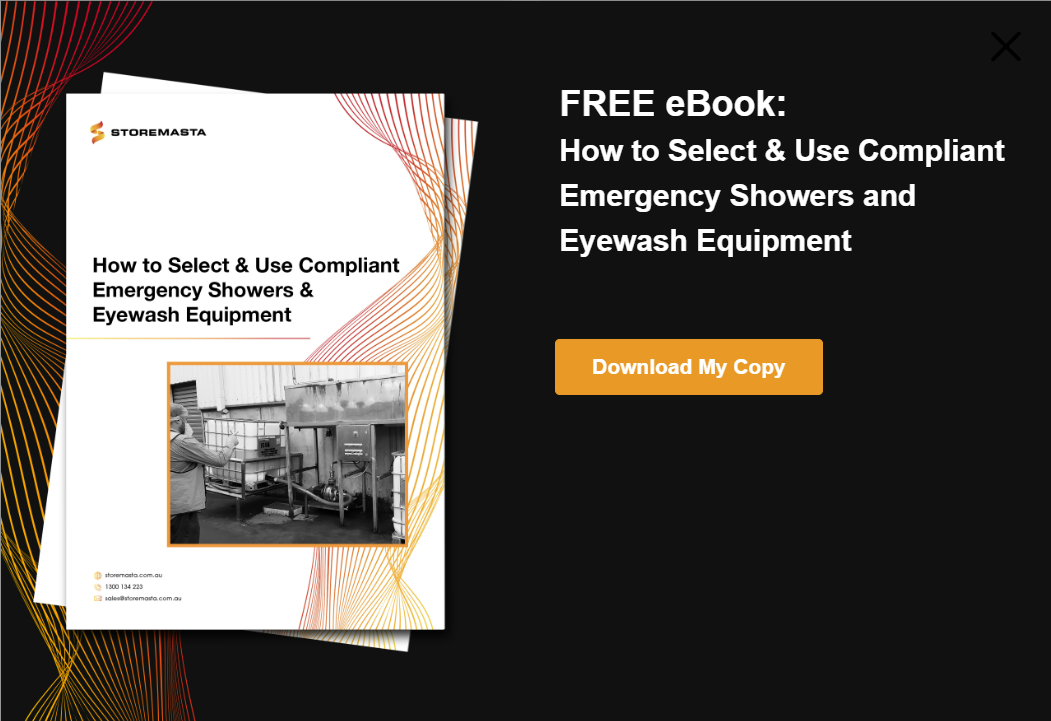Workplaces are dynamic spaces that are constantly evolving and expanding. However, a constantly changing environment has compliance implications — particularly when it relates to safety controls and emergency equipment. This post looks at some events in the workplace that could trigger the need for new (or expanded) emergency decontamination facilities. We’ll guide you through some common scenarios, so you can consider if it’s the right time to install a safety shower and eyewash station for your operations.
IMPORTANT: A risk assessment should be done when changes at the workplace occur that may impact on the effectiveness of control measures. Safe Work Australia.
A Change To Work Areas and Processes
If you start using different chemicals, production output increases, or you expand your workforce you will need to review the capacity of your decontamination stations. We recommend conducting a risk assessment to evaluate the effectiveness of your existing equipment whenever:
New hazardous substances are introduced
Every time you introduce new chemicals and Dangerous Goods into the workplace you need to evaluate your existing decontamination equipment. Check the hazard class and first aid recommendations on the Safety Data Sheets (SDS). Do you now need both a shower and an eyewash?
Production output increases
As production output increases will this increase the quantities of hazardous chemicals and Dangerous Goods you keep onsite? Are workers exposed to chemicals for longer periods of time? Are there now more work areas where staff could be affected by hazardous materials?
Workforce expands
If the number of onsite workers and contracts increases you may need to install additional eyewash and shower units. Is it possible that two or more workers need to use a safety shower or eyewash at the same time.
Renovations and construction work
The effectiveness of your emergency shower and eyewash stations may be impacted both during and after renovations or construction work. While the work is being undertaken your existing decontamination facilities may be obstructed by building materials and construction work. Then once the work is complete the layout of work areas may have changed, the existing shower may no longer be accessible to all employees and a second unit may be required.
Equipment and machinery installation
Installing new equipment and machinery can introduce new risks and hazards. Consider how the hazardous chemicals in the area could react with the equipment. Also evaluate if this change could increase the possibility of a worker being exposed to dusts and flying particles, splashed or immersed in liquid chemicals, or burned in a fire.

NOTE: The installation of additional equipment and machinery into a work area can introduce heat, sparks, and static electricity. Any of these could increases the risk of fire and explosions and trigger the need for emergency decontamination equipment.
Independent Audits and Inspections
Safety audits and inspections by qualified Dangerous Goods consultants can uncover new hazards and expose the limitations of your existing decontamination equipment.

Is there a need for new or expanded emergency decontamination equipment, such as safety showers and emergency eyewash facilities, at your site?
Examples include:
- Workers decanting or transferring fuel and hazardous chemicals outdoors and away from the indoor emergency eyewash and shower (may require outdoor installation).
- A single combination drench shower and eyewash to support 10 laboratory workers (insufficient equipment).
- Hand held drench hose being used as a safety shower or eyewash (inadequate equipment).
- Workers using a domestic shower in restrooms (non-compliant equipment).
- Self-contained eyewash with 15 minute flushing capacity to support lab workers who use both acids and bases (insufficient flushing time, may require plumbed eyewash).
IMPORTANT: Independent consultants and safety auditors who specialise in Dangerous Goods draw on their working knowledge of hazardous chemicals across a range of industries. These experts can help you appraise the adequacy of your existing (or proposed) installations.
An Accident, Incident or Near-Miss Occurs
Sometimes despite your best efforts, an accident, incident, or near miss will still occur. However, you can use this as an opportunity to conduct proper investigations and determine the cause of the incident.
Perhaps you’ve underestimated the potency of the chemicals. Or have you overlooked small groups of isolated workers?

Investigations into onsite incidences can highlight issues with your safety shower and eyewash facilities.
Here are some examples that might indicate inefficiencies in your decontamination equipment:
- Example 1: An explosion causes a vat of chemicals on a mezzanine floor to overturn and spill onto a worker below. The safety shower is located on the upper floor next to the vat.
Safety showers and eyewash facilties should be located in positions that are close to hazardous situations, but not so close that the hazard can affect the safety of the equipment.
- Example 2: A loose transfer coupling disconnects a fuel hose, two workers are sprayed with corrosive chemicals. There is only one safety shower, so one worker uses the shower while the other uses a drench hose.
There must be enough emergency decontamination equipment to provide relief for all affected workers.
- Example 3: A cleaner using corrosive cleaner/degreaser from a hand-pump unit receives 2nd degree burns to their hand when the chemicals leaked from the applicator. There was no available safety shower nearby so he used an outdoor garden hose.
An outdoor hose is not safe or suitable for decontamination purposes. Staff must have fast and easy access to safety showers and eyewash stations in the event of an emergency, as time is of the essence.
What To Consider Before Installing Emergency Equipment
Now that you’ve considered some situations that may require the installation of a safety shower or eyewash station, it’s a good idea to think about the work area – and how you can create a safe environment upon installation.
Here’s 5 simple points that may help you ensure a safer working environment when installing safety showers and eyewash stations.
1. Are potentially hazardous materials nearby?
Is there the potential for hazardous materials to create further safety issues in your immediate work area?
It’s important to accurately identify any potentially hazardous materials used or stored in the immediate area prior to installing your safety shower or emergency eyewash facility. You don’t want the activation of your safety shower to create another hazard or injure another worker.
Here some questions to ask:
- Could the water from the safety shower reach electrical equipment? Water entering switches, powerboards and batteries can cause fires and electrocution hazards.
- Are there any chemicals stored nearby that could react dangerously with water? Class 4 Dangerous Goods can ignite when in contact with water.
- What happens to the contaminated water? Wastewater could harm the environment and become a compliance issue with EPA.
- How will the worker’s contaminated clothing and personal effects be removed and managed? Clothing and PPE covered in highly corrosive chemicals thrown on the ground as a worker enters the shower could be picked up by another worker and injure them as well.
- Will the wastewater create a slip hazard? Workers slipping on water from the shower could be seriously injured or create another chemical emergency.
REMEMBER: When activating an emergency shower, you don’t want to expose the injured staff member (and first aiders) to additional hazards.
2. Could a worker be alone at the time of a chemical emergency?
Sometimes workers at outdoor and remote workstations can become isolated from their co-workers. Is there any chance that one of your workers could be completely alone at the time of a chemical emergency or fire? Some workplaces have duress alarms installed at their emergency decontamination stations or have workers wear electronic devices that can be activated in times of duress.
REMEMBER: An injured worker may not be able to operate an eyewash or safety shower and notify an ambulance or emergency services without assistance.
3. Does the location provide employees with privacy?
When a worker is splashed or immersed in hazardous chemicals, contaminants become trapped in their clothing and will continue to burn the skin even when standing under the safety shower. So many chemical emergencies require a contaminated worker to remove their clothing and sometimes that means everything. Therefore, it’s a good idea to consider the location of your safety shower, so your staff can focus solely on the decontamination process — instead of worrying about the lack of privacy.
You may also wish to consider the location point of the shower — as well as the type of training that will reinforce the need for injured workers to remove all their clothing. It could be buddy-training where one worker creates a privacy screen, while another assists an injured worker and secures their personal effects.
It’s really about making your workers feel confident their privacy will be respected, so they can focus on their safety and their health.
REMEMBER: Safety showers can’t minimise chemical burns and prevent deaths if workers don’t use them.
4. How will prevailing weather affect the operations of the emergency shower or eyewash station?
If your eyewash or emergency shower (or the supply pipes) are installed in a location that’s directly exposed to the weather, it may impact the usability and safety of the equipment.
Many worksites in regional Australia face extreme heat and cold at different times of year and this could impact the temperature of the water flowing out of the shower. Extremely hot water could scold a worker and magnify their injury, while extremely cold water will make the patient uncomfortable and they might be unwilling to stay under the shower for the full treatment time.
REMEMBER: An emergency shower is useless if the water in the pipes is frozen solid, or unsafe if the water in the pipes is 50°C after sitting in the sun all day.
5. Can emergency response teams easily access the patient?
Another key consideration when determining whether you need to install a safety shower or emergency eyewash in your workplace is how easily response teams can access the patient.

Does the position of your equipment allow for the successful treatment of injured staff by emergency services and response teams?
Where are the access points for paramedics and emergency response teams to enter your facility. If the shower is installed indoors, how close is the shower to an emergency exit? Could an emergency responder safely administer O2 in the area? Will their movements be restricted? If the shower is outdoors could an ambulance drive right up to the accident scene or the shower?
Need to Install a Safety Shower or Emergency Eyewash?
If you’re still not sure whether you need a safety shower, eyewash station or supplementary equipment like drench hoses to support your existing installation, why not download our free eBook How to select and use compliant emergency showers and eyewash equipment. It’s the definitive compliance guide for installing emergency decontamination equipment in Australia.
Joining the team as a Dangerous Goods Storage Consultant, Melissa Hampton became Storemasta's Marketing Manager in late 2021. With extensive knowledge and experience in chemical compliance, Melissa is responsible for leading the Marketing team and helping shape their marketing strategy. In her spare time, you can find Melissa hiking, swimming and enjoying the great outdoors in beautiful north-west Tasmania.
